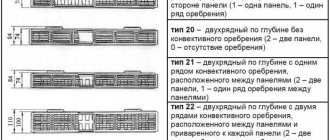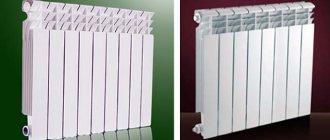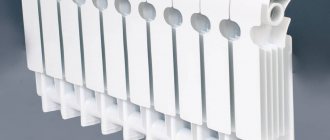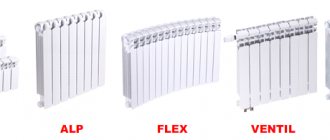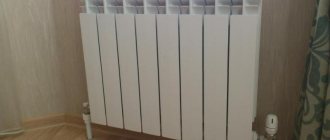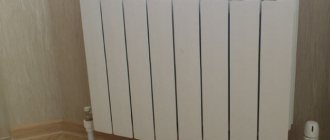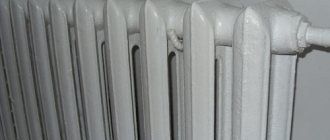Appearance ↑
Kermi have truly become a recognized leader in their segment. Their steel panel radiators (and not only) have become widely known in the world, and popularity, as you know, is the second component of success. And quality. Today the company produces not only its traditional steel batteries, but also bimetallic ones. They have two types of connection - bottom and side. And three different thicknesses of metal.
Steel radiators are more suitable for country houses, where the pressure is not as high as in the city. Steel radiators are at risk of water hammer; bimetallic batteries are capable of maintaining pressure up to 30 atmospheres.
In order not to waste your time by describing their external advantages, I suggest watching a short video about these devices below, so you can form your own idea about them.
Consumers are interested in different models, including decorative batteries with an unusual stylish design
The heating equipment of the radiator series is mainly intended for individual houses and cottages, and have a corresponding appearance: refined, elegant, noble. This is not to say that they are cheap, but they say that the costs are justified by the high degree of comfort.
In fact, the operation of any liquid radiator is based on one principle - the coolant (in this case it is water) enters the radiator tank and slows down, gradually cooling down and transferring heat into the room.
The main advantage of these devices is their high specific thermal power. So Kermi radiators are considered very powerful.
Batteries transfer heat by thermal radiation from the front surface and have very decent heat transfer. They are usually installed in autonomous heating systems, since they are designed for low operating pressure.
It’s hard to disagree with the fact that the appearance of Kermi brand radiators is quite aesthetic. Batteries come in different sizes. Radiators are mainly produced in white color, they are coated with a special powder coating (according to the manufacturer, it is environmentally friendly! I have not yet seen any refutations, so it is quite possible that this is true), which seems to allow you to maintain the temperature longer. But there are decorative models that differ from the main line in both color and design.
Radiators therm-x2® Profil, Plan, Line
These are compact steel heating devices with a traditional horizontal layout. This series owes its name to the design of the panels - they have vertically oriented profiling. Molding simultaneously increases the rigidity of the structure and the heat transfer area.
The coolant supply can be lateral (marked FKO) or bottom (FTV) coolant inlet/outlet. In the first case, the radiators are marked Profil-K (compact). For connection, pipes with ½″ internal thread are used. In addition to the device itself, the delivery set includes mounting brackets, plugs and a Mayevsky valve (air vent).
Valve radiators with bottom (FTV) coolant inlet/outlet use a ¾″ external thread for connection. The kit comes with already installed plugs, an air vent and an integrated thermostatic valve. It is factory set and is used to hydraulically balance the system. To be able to change presets, you will have to additionally purchase and install a thermal head.
Such radiators can operate at pressures up to 10 bar and coolant temperatures up to 110ºС, without loss of efficiency and safety. Installation dimensions vary in height (from 300 to 900 mm), length (400...3000 mm) and depth (61, 100 and 155 mm depending on the series/number of panels).
Other horizontal radiators therm-x2® Plan and therm-x2® Line have similar dimensions, connection methods, configuration and classification. The only difference is in the design of the panels: in the Plan series it is completely smooth, while in the Line it has barely noticeable horizontal grooves (linear profiling).
About the manufacturer ↑
The German company Kermi was founded back in 1960. Since 1967, the company has been closely involved in the production of steel panel radiators. (By the way, since 1976 it has also been closely involved in the production of shower cabins). And by 1975, Kermi had achieved a leading position in this segment. Kermi best known in Germany itself, but they are also well known in other European countries.
These heating batteries have appeared on the Russian market relatively recently, but they are trusted. And the 5-year warranty from the manufacturer is certainly captivating.
Characteristics ↑
Each of the Kermi brand's snow-white products launched on the market is equipped with a side panel and a top grille. Each battery is tested at the factory at a pressure of 10-13 bar before entering the market.
Complete with the device itself, the manufacturer also supplies special air vent plugs and brackets.
The number of radiator panels is indicated on the marking:
- type 10 - one panel;
- type 11 - panel with fins;
- type 21 - a pair of panels and one fin;
- type 22 - a pair of panels and a pair of fins;
- type 33 - three panels and three rows of fins.
Thanks to the enviable variety of radiator sizes, they can be selected to suit any room and any location.
If a massive radiator with dimensions of 300 x 2000 mm requires a fairly spacious room, and sometimes it is possible to assemble it almost on the street under a window, then compact models of Kermi radiators (for example, 45 mm in depth) are not at all difficult to install at home.
Steel panel heating radiators of the Kermi brand are impeccable quality devices with high heat output and stylish design.
- Height in the range of 300-900 mm;
- Length in the range of 400-3000 mm;
- Kermi radiators are produced as single-layer, double-layer and three-layer.
Kermi steel panel radiators are designed as a pair of panels connected by metal pipes where the heated coolant flows. The design of conventional radiators involves the circulation of coolant simultaneously through two panels, in this case the result is uniform heating of the radiator surface. Not so long ago, such a method of heating the coolant was considered the most rational.
But Kermi steel radiators, manufactured using special Therm X2 technology, are made differently. The coolant in radiators first passes through the front panel, and after that it is supplied through pipes to the rear panel.
Such coolant circulation contributes to faster heating of the front panel, which increases the power of the actual thermal radiation. A slightly cooled coolant circulates in the rear radiator panel, causing the panel to warm up a little longer.
Should this nuance be considered a design flaw? Perhaps even the opposite. The fact is that the rear panel of the radiator in this case plays the role of a good screen, thanks to which unnecessary heat losses are prevented and there is almost no useless energy consumption for heating the wall.
Panel steel heating radiators KERMI ThermX2
Made according to all European standards, they have a wavy profile surface and are notable for their low price. They are only suitable for closed heating systems. The small volume of hot water coupled with high heat output makes these devices most suitable for autonomous heating. Moreover, it is better to use them in systems where the coolant is not excessively hot.
These radiators are made using the latest patented X2 technology, which significantly increases the efficiency of heating devices. By doubling the radiation of the infrared spectrum, this technology made radiators very comfortable. Heating time has accelerated by about a quarter, and savings have increased by 11%. The meaning of the X2 principle is that the front panel heats up first, and only after that the back panel. For more information about this, see the video below.
Video. Technical features of Kermi steel panel radiators
After joining the panels into a body, the finished product is first thoroughly degreased, then it is phosphated. The final finishing is done using electrostatic painting. The top layer of paint is processed at a temperature of 180 degrees. This makes it durable. The shiny coating gives the batteries an elegant look.
The radiator has screen grilles on the top and sides. They can achieve a significant increase in heat transfer efficiency - by 60%. The set includes 4 pads designed for attaching equipment.
There are 2 lines of Kermi panel radiators, which differ in the location of connection to the heating network. Radiators from the Kermi ThermX2 Profil-K (FKO) line are connected to the side. And devices such as Kermi ThermX2 Profil-V (FKV or FTV) are designed for connection from below.
Side-connected Kermi ThermX2 Profil-K
These radiators are equipped with convectors, and their panels are made of two profiled steel sheets connected by welding. There are screens on the sides, and an overhead grill-type grill on top. Radiators with a side connection type are marked with the letter combination FKO. To connect to the system on the sides, the Kermi Profil-K FKO device has four pipes with internal threads (1/2″ diameter). The radiator can be connected to the pipes from any side.
Technical characteristics of heating radiators Kermi ThermX2 FKO:
- Connecting thread: 4 x G1/2” (internal)
- Height: 300, 400, 500, 600, 900
- Center distance: total height minus 50 mm
- Length: from 400mm to 3000mm
- Depth: type 10 and 11 - 61mm, type 12 - 64mm, type 22 - 100mm, type 33 - 155mm
- Working pressure – 10 atm. (1.0 MPa)
- Crimping pressure – 13 atm. (1.3 MPa)
- Max. coolant temperature: 110°C
- Operating temperature – 95°
Bottom-connected Kermi ThermX2 Profil-V
All of these radiators have a thermal valve built into the design. Its thread is right-handed, with a pitch of M30x1.5. The temperature controller is not included in the package; it must be purchased separately. The thread of the pipe is external, its diameter is 3/4″. The center-to-center distance is 5 cm. This design is intended for two-pipe heating systems. If you need to connect to a single-pipe system, then purchase special fittings.
Technical characteristics of Kermi ThermX2 FKV:
- Connecting thread: 2 x G3/4” (external),
- Radiator heights: 300, 400, 500, 600, 900
- Radiator length: from 400mm to 3000mm
- Distance between supply pipes: 50mm
- Radiator depth: type 10 and 11 - 61mm, type 12 - 64mm, type 22 - 100mm, type 33 - 155mm
- Working pressure – 10 atm. (1.0 MPa)
- Crimping pressure – 13 atm. (1.3 MPa)
- Maximum coolant temperature: 110°C
- Operating temperature – 95° C
In addition to connection methods, panel radiators also differ in type. In total, Kermi produces 5 types of steel panel radiators:
Type 10 is single-row, has a depth of 6.1 cm. There is no cladding or convector. Manufactured by pre-order only.
Type 11 - single-row, lined, depth - 6.1 cm. There is one convector.
Type 21 – double-row, lined, with a depth of 6.4 cm. One convector.
Type 22 – double-row, lined. Two convectors.
Type 33 – three-row, lined. Three convectors.
The most popular and frequently used is type 22.
Power ↑
Kermi radiator power table
When talking about the advantages of Kermi, it is considered necessary to remember such innovative technology, which is patented by a company like ThermX2. It is precisely due to the fact that the coolant in the battery first warms up the outer panel facing the room, and only after that it enters the rear panel, the device provides thermal energy savings of up to 11%.
Kermi Profil - Kompakt FKO panel radiators have a side or bottom connection. Kermi FKO devices, having a side connection, are intended for heating rooms as in standard heating systems with coolant temperatures up to 110 degrees. C, and in systems with lower temperature indicators.
Kermi batteries can be connected to the system from either side (right or left). Kermi devices function well in heating systems based on forced circulation of coolant. Radiators Kermi Profil - Ventil FKV, with a basic bottom connection, are designed to work in a wide variety of heating systems at any coolant temperature. Special thermostatic valves are installed in Kermi radiators.
Nothing prevents radiators from working in heating systems with any type of coolant circulation.
Determining the power of radiators based on the volume of the room
According to building codes, one cubic meter of room requires the following heat transfer:
- in panel buildings – 0.041 kW;
- in brick - 0.034 kW.
For example, let’s take a room in a brick building. Ceiling height – 2.7 m. Walls 3 and 5 m long. Room volume – 40.5 m3. To obtain the average power indicator, it is necessary to multiply the volume by a factor of 0.034 kW. The result of the product (40.5x0.034) is 1.377 kW (1377 W).
But this result is valid only for the average climate zone and without taking into account the correction depending on the number of external walls and windows. The illustration shows the dependence of the coefficients on the average winter temperature.
Some coefficients by which you need to multiply the average required heat transfer, depending on the number of external walls and windows, as well as taking into account the location of window openings:
- 1 external wall – 1.1;
- 2 external walls and 1 window – 1.2;
- 2 external walls and 2 windows – 1.3;
- the windows “look” towards the north – 1.1.
If radiators are supposed to be installed in a niche, then for Kermi batteries the power calculation is adjusted taking into account a factor of 0.5. If the thermal structure is covered with a perforated panel, the average value should be multiplied by 1.15.
For example, in our conditional room with a volume of 40.5 there are two walls facing the street. At the same time, the average temperature in winter is -30. In this case, we multiply the resulting heat transfer by the required coefficients - 1377x1.2x1.5 = 2478.6 W. The rounded result is 2480 W.
This number is relatively accurate, but the matter is not limited to the mentioned coefficients. When making thermal calculations, specialists take into account what material the walls are made of, the characteristics of the surrounding rooms, etc. But, provided that the average indicators are averaged, this number can be used. To determine the type of batteries, the power table of Kermi radiators is used.

